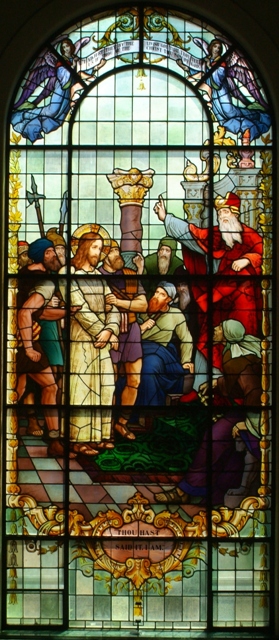
Trial before the Sanhedrin
The Passion begins at St. John’s with Jesus’ trial before the Sanhedrin in a window on the east wall. The Gospels tell us that the Sanhedrin, certain Pharisees and some partisans of Herod did not believe Jesus to be the Messiah and for this reason sought to destroy him. The Sanhedrin ordered him to be arrested and brought in for questioning. In John’s Gospel he appeared first before Annas, the father-in-law of Caiaphas, and then Caiaphas. Jesus’ trial opened with the priest and scribes seeking false witnesses against him from those in the crowd, which had gathered around. Only two came forward and made accusations, to which Jesus said nothing. Caiaphas then posed to Jesus the quote at the top of window, “I adjure thee by the living God that thou tell us if thou be the Christ the Son of God.” To which Jesus replied, “Thou hast said it.” (Matt. 26:63). The cartouche at the bottom of the window cites this quote and adds. “I am.” (Mark 14:62) Jesus goes on to say, “You shall see the son of man sitting on the right hand of the power of God and coming in the clouds of heaven.” Claiming that Jesus blasphemed, the Sanhedrin condemned him to death and delivered him to Pilate for sentencing. In the window Jesus is brought before Caiaphas by a group of soldiers. Two hold him fast, while others brandish weapons against him. The artist has rendered the “swords and clubs” of the Gospels as medieval arms, a transformation resulting most likely from reuse of an earlier composition. Evident throughout the stained-glass cycle is the designer’s reliance on medieval art and thus we should not be surprised to see medieval arms at Christ’s trial. Jesus stands between the soldiers who grip him with arms bound in front of him and eyes cast downward; he wears a simple robe. Opposite him, Caiaphas sits on a richly adorned throne; the high priest stares at Jesus and gestures wildly at him. Between the accuser and accused are four members of the Sanhedrin. One holds a book rather than a scroll, the traditional form for Jewish sacred writing. (For a discussion of the anachronistic insertion of books into the stained-glass program, see the essay on Jesus teaching in the temple p. 14-15)
The window collapses several moments into one, resulting in the illusion that the trial is unfolding before our eyes. The soldier’s walking stances indicate movement and their gazes to Caiaphas imply arrival. Thus, if we focus on them, we read the image as Jesus’s entrance at court. Jesus’ firmly planted feet, gaze toward the man with the book and still countenance, however, suggest the later event of the false witness’ accusation. Caiaphas’ upward gesture, coupled with the quote at the top of the window, shifts the narrative to the point in time when Caiaphas asks Jesus if he is the Son of God. Another narrative moment is evoked if the window’s imagery is read in the context of the entire stained glass program. Jesus’ statement made just before entering court “I sat daily with you, teaching in the temple…” is alluded to in the presence of the twisted column and in conjunction with the window of Jesus teaching in the temple, which is located exactly opposite on the west side of the nave. Legend claims that twisted columns adorned Solomon’s temple and for this reason Christians adopted the form for their houses of worship. At St. John’s the column signifies the temple and thus prompts thought on Christ’s statement
The window collapses several moments into one, resulting in the illusion that the trial is unfolding before our eyes. The soldier’s walking stances indicate movement and their gazes to Caiaphas imply arrival. Thus, if we focus on them, we read the image as Jesus’s entrance at court. Jesus’ firmly planted feet, gaze toward the man with the book and still countenance, however, suggest the later event of the false witness’ accusation. Caiaphas’ upward gesture, coupled with the quote at the top of the window, shifts the narrative to the point in time when Caiaphas asks Jesus if he is the Son of God. Another narrative moment is evoked if the window’s imagery is read in the context of the entire stained glass program. Jesus’ statement made just before entering court “I sat daily with you, teaching in the temple…” is alluded to in the presence of the twisted column and in conjunction with the window of Jesus teaching in the temple, which is located exactly opposite on the west side of the nave. Legend claims that twisted columns adorned Solomon’s temple and for this reason Christians adopted the form for their houses of worship. At St. John’s the column signifies the temple and thus prompts thought on Christ’s statement